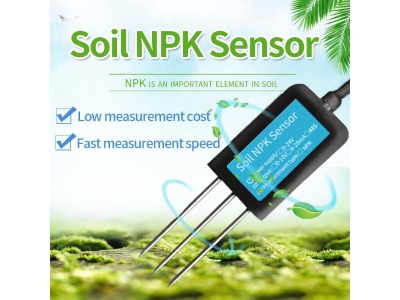Precision agriculture, also known as smart farming, has revolutionized the agricultural industry by integrating advanced technologies to optimize crop production and enhance resource management. One of the key technologies driving this transformation is soil sensor technology. Soil sensors enable farmers to gather real-time data about soil conditions, thereby allowing for targeted interventions and precise decision-making. In this article, we will explore how soil sensor technology is unleashing the potential of precision agriculture, leading to improved productivity, resource efficiency, and environmental sustainability.

Understanding Soil Sensor Technology
Soil sensors are devices designed to measure and analyze various soil parameters, including moisture content, temperature, pH level, nutrient composition, and salinity. These sensors are typically embedded in the soil at different depths and locations across a field, enabling comprehensive monitoring of soil conditions. The data collected by these sensors can be transmitted wirelessly to a central database or analyzed on-site using specialized software.
Optimizing Irrigation Practices Water is a precious resource
and efficient irrigation is crucial for sustainable agriculture. Soil sensors play a vital role in optimizing irrigation practices by providing accurate information about soil moisture levels. By monitoring soil moisture in real-time, farmers can determine when and how much water is needed, precisely matching irrigation to the crop’s requirements. This targeted irrigation approach minimizes water wastage, prevents over- or under-watering, and promotes healthy plant growth.
Assessing Nutrient Levels Maintaining
optimal nutrient levels in the soil is essential for crop health and productivity. Soil sensors help farmers assess nutrient levels accurately, enabling them to apply fertilizers and soil amendments in a precise and timely manner. By measuring nutrient parameters such as nitrogen, phosphorus, and potassium, farmers can avoid excessive fertilization, reduce environmental pollution, and ensure that crops receive the necessary nutrients for optimal growth.
Monitoring Soil pH and Salinity Soil pH and salinity
levels significantly impact crop growth and yield. Soil sensors provide continuous monitoring of these parameters, allowing farmers to take corrective measures promptly. By monitoring soil pH, farmers can adjust the soil’s acidity or alkalinity to create an optimal growing environment for specific crops. Similarly, monitoring soil salinity helps in managing salt accumulation, which can hinder plant growth. With soil sensor technology, farmers can maintain ideal pH and salinity levels, maximizing crop productivity.
Detecting Soil Compaction Soil compaction
caused by heavy machinery or excessive foot traffic, negatively affects root development and nutrient uptake. Soil sensors can detect soil compaction by measuring soil density and moisture content. This information helps farmers identify compacted areas and take remedial action, such as targeted tillage or soil aeration, to enhance soil structure and root penetration. By addressing soil compaction issues promptly, farmers can improve overall soil health and boost crop performance.
Integrating Sensor Data with Other Technologies
The power of soil sensor technology is further amplified when integrated with other advanced agricultural technologies. For instance, combining soil sensor data with satellite imagery, weather forecasts, and crop growth models enables farmers to make data-driven decisions regarding planting, harvesting, and pest management. By harnessing the potential of multiple technologies, precision agriculture becomes more holistic and efficient.
Overcoming Challenges
and Future Prospects Although soil sensor technology holds great promise for precision agriculture, there are challenges that need to be addressed. Cost is one major hurdle, as the initial investment in soil sensors and related infrastructure can be significant. Furthermore, ensuring the accuracy and reliability of sensor data, managing large datasets, and providing user-friendly interfaces for farmers require ongoing research and development.
Looking aheadadvancements in sensor technology
wireless connectivity, and data analytics hold immense potential for the future of precision agriculture. As costs reduce and sensor networks become more accessible, soil sensor technology will become increasingly integrated into farming practices. Moreover, advancements in artificial intelligence and machine learning algorithms will enable the development of predictive models, optimizing crop management strategies based on historical and real-time sensor data.

Conclusion
Soil sensor technology is revolutionizing precision agriculture by allowing farmers to make informed decisions based on real-time data. From optimizing irrigation practices to assessing nutrient levels and detecting soil compaction, soil sensors unlock the potential for improved productivity, resource efficiency, and sustainability. As this technology continues to evolve and become more accessible, it will play a pivotal role in shaping the future of agriculture, ensuring food security, and promoting environmental stewardship. By embracing soil sensor technology, farmers can unleash the full potential of their land while minimizing their environmental footprint.
